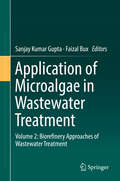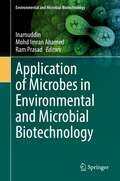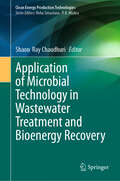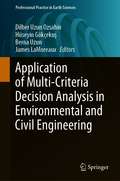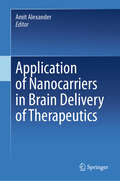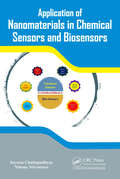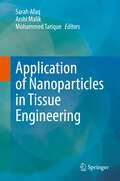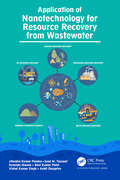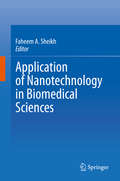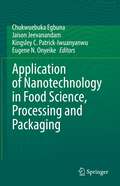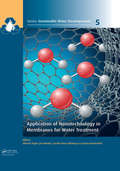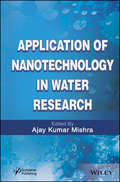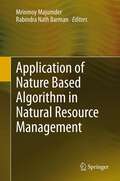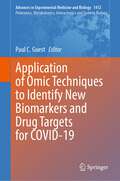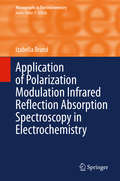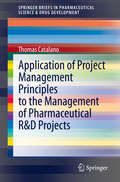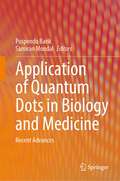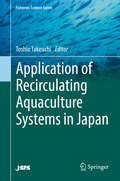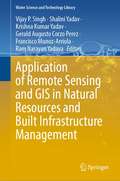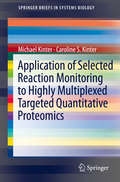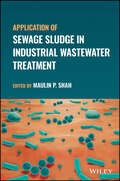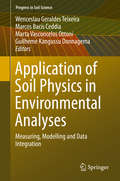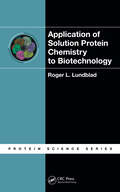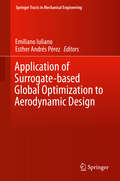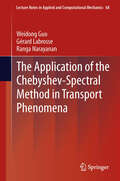- Table View
- List View
Application of Microalgae in Wastewater Treatment: Volume 2: Biorefinery Approaches of Wastewater Treatment
by Sanjay Kumar Gupta Faizal BuxThis two-volume work presents comprehensive, accurate information on the present status and contemporary development in phycoremediation of various types of domestic and industrial wastewaters. The volume covers a mechanistic understanding of microalgae based treatment of wastewaters, including current challenges in the treatment of various organic and inorganic pollutants, and future opportunities of bioremediation of wastewater and industrial effluents on an algal platform. The editors compile the work of authors from around the globe, providing insight on key issues and state-of-the-art developments in algal bioremediation that is missing from the currently available body of literature. The volume hopes to serve as a much needed resource for professors, researchers and scientists interested in microalgae applications for wastewater treatment. Volume 2 addresses the various biorefinery aspects and applications of algal-based wastewater treatment in industrial and domestic contexts. The analyses are approached from multiple perspectives, including biotechnology, commercial, economic, and sustainability. The authors discuss the potential of microalgae for integrated biomass production utilizing various resources to treat wastewaters, and include evaluations of the economical and commercialization potential for such processes.
Application of Microbes in Environmental and Microbial Biotechnology (Environmental and Microbial Biotechnology)
by Inamuddin Ram Prasad Mohd Imran AhamedThis comprehensive edited book on microbial prospective discusses the innovative approaches and investigation strategies, as well as provides a broad spectrum of the cutting-edge research on the processing, properties and technological developments of microbial products and their applications. Microbes finds very important applications in our lives including industries and food processing. They are widely used in the fermentation of beverages, processing of dairy products, production of pharmaceuticals, chemicals, enzymes, proteins and biomaterials; conversion of biomass into fuel, fuel cell technology, health and environmental sectors. Some of these products are produced commercially, while others are potentially valuable in biotechnology. Microorganisms are considered invaluable in research as model organisms. This is a useful compilation for students and researchers in microbiology, biotechnology and chemical industries.
Application of Microbial Technology in Wastewater Treatment and Bioenergy Recovery (Clean Energy Production Technologies)
by Shaon Ray ChaudhuriThis book explores microbial intervention in wastewater treatment for resource recovery, bioenergy production, and environmental sustainability. It discusses the fate of pollutants, challenges in existing treatment strategies, and the need for innovation. Case studies illustrate wastewater-specific treatment strategies for bioenergy and resource recovery at different scales. The book emphasizes the use of wastewater for resource recovery through sequestration or biotransformation and highlights tailormade consortium development for sludge-free treatment. It also covers sustainable approaches like microbial biofilm reactors, microbial fuel cells and membrane technology for wastewater treatment. It also deals with nanotechnology in combination with microbial technology for handling refractory components in wastewater that could not be handled by microbes alone. This book provides insights into microbial technology for a clean environment and bioenergy production through a reduce, recover, and reuse approach. This valuable resource offers practical information that can be applied by engineers, researchers, and undergraduate and graduate students, as well as business professionals in the bioenergy field, aiding them in the implementation of renewable energy projects.
Application of Multi-Criteria Decision Analysis in Environmental and Civil Engineering (Professional Practice in Earth Sciences)
by Dilber Uzun Ozsahin Hüseyin Gökçekuş Berna Uzun James LaMoreauxThe use of a multi-criteria, decision-making theory was first studied in the 1970s. Its application in civil and environmental engineering is a new approach which can be enormously helpful for manufacturing companies, students, managers, engineers, etc. The purpose of this book is to provide a resource for students and researchers that includes current application of a multi-criteria, decision-making theory in various fields such as: environment, healthcare and engineering. In addition, practical application are shown for students manually. In real life problems there are many critical parameters (criteria) that can directly or indirectly affect the consequences of different decisions. Application of a multi-criteria, decision-making theory is basically the use of computational methods that incorporate several criteria and order of preference in evaluating and selecting the best option among many alternatives based on the desired outcome.
Application of Nanocarriers in Brain Delivery of Therapeutics
by Amit AlexanderThis book presents nanoparticles as potential drug delivery carriers for overcoming the blood-brain barrier. The initial chapter of the book discusses complex brain disorders, the currently available therapies, and their limitations. The book discusses the potential applications of polymeric nanoparticles, lipid nanocarriers, liposomes, inorganic nanoparticles, dendrimers, and stimuli-responsive polymers for targeted brain drug delivery. Further, it evaluates the development and role of different cell lines and animal models in brain research. Towards the end, the book reviews challenges, safety, toxicity, regulatory aspects, future possibilities, and constraints in the clinical translation of nanocarrier systems to treat neurological disorders. The book as such provides valuable information to neuroscientists, and researchers working in pharmaceuticals, nanomedicine, drug delivery research, and nanotechnology.
Application of Nanomaterials in Chemical Sensors and Biosensors
by Jayeeta Chattopadhyay Nimmy SrivastavaRecent advances in nanotechnology has led the nanomaterials into the realm of sensing applications. This descriptive book utilizes a multi-disciplinary approach to provide extensive information about sensors and elucidates the impact of nanotechnology on development of chemical and biosensors for diversified applications. The main focus of this book is not only the inclusion of various research works, which have already been reported in literature, but also to make a potential conclusion about the mechanism behind this. This book will serve as an invaluable tool for both frontline researchers and academicians to work towards the future development of nanotechnology in sensing devices.
Application of Nanoparticles in Tissue Engineering
by Sarah Afaq Arshi Malik Mohammed TariqueThis book discusses advancements in the applications of nanoparticles in tissue engineering. It examines the applications of nanobiomaterials in hard tissue regeneration, fabrication, and characterization. The book also analyzes the implication of three-dimensional and four-dimensional fabrication techniques for the production of the scaffold in tissue engineering and their advantages over conventional scaffold production techniques. Further, it presents smart materials used in making 4-D scaffolds that imitate the dynamic response of tissue against natural stimuli and adapt to the microenvironment by changing their conformation or other properties. It also summarizes the growing field of biomolecular detection and biosensors in tissue engineering and the increasing prominence of nanoparticles in the biosensors. Further, it provides the future outlook and associated challenges of the application of nanomaterials in tissue engineering.
Application of Nanotechnology for Resource Recovery from Wastewater
by Jitendra Kumar Pandey Syed M. Tauseef Suvendu Manna Ravi Kumar Patel Vishal Kumar Singh Ankit DasgotraMost of the time, industrial wastes contain recoverable resources that would be useful in other applications. For example, greywater have enough nutrient to support the growth of microalgal biomass that are useful for biofuel production. Similarly, solid waste generated in metal extraction industries often contain high concentration of other metals that could be extracted using various processes. This book presents a critical overview on the current nanotechnologies that are being utilized for extraction of valuable resources from various industrial and domestic wastes. This book presents research, reviews, and case studies on the extraction of metal, organic compounds, energy and nutrients from waste through nanotechnological interventions.
Application of Nanotechnology in Biomedical Sciences
by Faheem A. SheikhThis book highlights the wide applications of nanomaterials in healthcare and environmental remediation. Presenting nano-based materials that positively influence the growth and proliferation of cells present in soft and hard tissue and are used for the regeneration bone tissue and/or suppression of cancer cells, it also discusses the natural products that can be incorporated in nanofibers for the treatment of cancer. Further, it describes the use of blending and functionalization to produce chitosan nanofibers for biomedical applications, and reviews the role of plasma-enhanced gold nanoparticles in diagnostics and therapeutics. Lastly, the book also introduces various nanotechnology approaches for the removal of waste metabolites in drinking water, and explores the emerging applications of nanorobotics in medicine. Given its scope, this book is a valuable resource for scientists, clinicians, engineers and researchers aiming to gain a better understanding of the various applications of nanotechnology.
Application of Nanotechnology in Food Science, Processing and Packaging
by Chukwuebuka Egbuna Jaison Jeevanandam Kingsley C. Patrick-Iwuanyanwu Eugene N. OnyeikeThis book entitled ‘Application of Nanotechnology in Food Science, Processing and Packaging’ presents up-to-date information on the emerging roles of nanotechnology in food industry, its fundamental concepts, techniques and applications. The application of nanotechnology in the food industry is an emerging area which has found tremendous use in improving food quality through the enhancement of food taste, texture, colour, and flavour. Also, its application has improved the bioavailability and target delivery of certain bioactive food ingredients through controlled release of nutrients, a feature that is impossible with the conventional methods of food processing. The application of nanotechnology in food packaging for the detection of contaminants, pathogens, biotoxins and pesticides through nanosensor safety evaluations has led to the increase in shelf-life of products and quality assurance through the detection and monitoring of toxins. This book taps from the experience of subject experts from key institutions around the world. The users of this book will benefit greatly as the chapters were simplified and arranged carefully to aid proper understanding, consistency and continuity.
Application of Nanotechnology in Membranes for Water Treatment (Sustainable Water Developments - Resources, Management, Treatment, Efficiency and Reuse)
by Alberto Figoli Jan Hoinkis Sacide Alsoy Altinkaya Jochen BundschuhThe book focuses on Application of Nanotechnology in Membranes for Water Treatment but not only provides a series of innovative solutions for water reclamation through advanced membrane technology but also serves as a medium to promote international cooperation and networking for the development of advanced membrane technology for Universal well-being and to achieve the common goal of supplying economically, environmentally and societally sustainable freshwater and better sanitation systems. This book is unique because the chapters were authored by established researchers all around the globe based on their recent research findings. In addition, this book provides a holistic coverage of membrane development for water treatment, from the membrane preparation and characterizations to the performance for specific processes and applications. Since that water scarcity has become a global risk and one of the most serious challenges for the scientific community in this century, the publication of this book is therefore significant as it will serve as a medium for a good reference of an alternative solution in water reclamation. This book will provide the readers with a thorough understanding of the different available approaches for manufacturing membranes both with innovative polymeric systems and inorganic nano-materials which could give enhanced functionalities, catalytic and antimicrobial activities to improve the performance of the existing membranes. It will be useful for leading decision and policy makers, water sector representatives and administrators, policy makers from the governments, business leaders, business houses in water treatment, and engineers/ scientists from both industrialized and developing countries as well.
Application of Nanotechnology in Water Research
by Ajay Kumar MishraAt the nano size materials often take on unique and sometimes unexpected properties which results in materials being 'tuned' to build faster, lighter, stronger and more efficient devices and systems, as well as new classes of materials. In the water research, nanotechnology is applied to develop more cost-effective and high-performance water treatment systems as well as instant and continuous ways to monitor water quality as well.Nanotechnology in water applications potentially impacts on treatment, remediation, sensing, and pollution prevention. Nanotechnology for water treatment and remediation has the potential to maintain the long-term water quality, availability and viability of water resource. Thus, water via nanotechnology can be reused, recycled, desalinized and also it can detect the biological and chemical contamination at even very low concentration no matter if it is coming from municipal, industrial or man-made waste. Water Research Nanotechnology Applications describes a broad area of nanotechnology and water research where membrane processes (nanofiltration, ultrafiltration, reverse osmosis and nanoreactive membranes) are considered key components of advanced water purification and desalination technologies to remove, reduce or neutralize water contaminants that threaten human health and/or ecosystem productivity and integrity. Various nanoparticles and nanomaterials that could be used in water remediation (zeolites, carbon nanotubes, self-assembled monolayer on mesoporous supports, biopolymers, single-enzyme nanoparticles, zero-valent iron nanoparticles, bimetallic iron nanoparticles, and nanoscale semiconductor photocatalysts) are also discussed. Water-borne infectious diseases as well as water-borne pathogens, microbes and toxicity approach receive attention.
Application of Nature Based Algorithm in Natural Resource Management
by Mrinmoy Majumder Rabindra Nath BarmanThis book highlights the application of nature-based algorithms in natural resource management. The book includes the methodologies to apply what natural flora or fauna do to optimize their survival. The same technique was used to optimize renewable energy generation from water resources, maximization of profit from crop harvesting, forest resource management and decision-making studies. These studies can be used as an example for finding solutions of the other maximization or minimization problems which are common in natural resource management.
Application of Omic Techniques to Identify New Biomarkers and Drug Targets for COVID-19 (Advances in Experimental Medicine and Biology #1412)
by Paul C. GuestThe COVID-19 pandemic caused by the SARS-CoV-2 virus has affected nearly every country and territory in the world. Although worldwide vaccination efforts have reduced the risk of serious disease outcomes, disparities in distribution have led to multiple waves of SARS-CoV-2 outbreaks and the emergence of variants of concern, some of which have enhanced infectivity and ability to evade existing vaccines. Hence there is an increasing interest in understanding the evolution of viruses like SARS-CoV-2, as well as improving our capacity to effectively current and manage future pandemics.This new volume reviews the most effective omic techniques for increasing our understanding of COVID-19, to improve diagnostics, prognostics, and genomic surveillance, and to facilitate development of effective treatments and vaccines. Chapters are written by an international team of experts and explore methods in the areas of genomics, transcriptomics, proteomics, and metabolomics. Techniques used to assess physiological function at the molecular level and artificial intelligence approaches used for more effective validation and translation of biomarker candidates into clinical use are also discussed. This book is an excellent resource for researchers studying biomarkers, virology, metabolic diseases, and infectious diseases, as well as clinical scientists, physicians, drug company scientists, and healthcare workers.
Application of Polarization Modulation Infrared Reflection Absorption Spectroscopy in Electrochemistry (Monographs in Electrochemistry)
by Izabella BrandThis book describes the physical basis of polarization modulation infrared reflection-absorption spectroscopy and its application in electrochemical studies. It provides a concise yet comprehensive review of the research done in this field in the last 20 years. Electrochemical methods are used to determine the rate and mechanism of charge transfer reactions between an electrode and species adsorbed or diffusing to its surface. In the past two decades PM-IRRAS has grown to be one of the most important vibrational spectroscopy techniques applied to investigate structural changes taking place at the electrochemical interface. The monograph presents foundations of this technique and reviews in situ studies of redox-inactive and redox-active films adsorbed on electrode surfaces. It also discusses experimental conditions required in electrochemical and spectroscopic studies and presents practical solutions to perform efficient experiments. As such, it offers an invaluable resource for graduate and postgraduate students, as well as for all researchers in academic and industrial laboratories.
Application of Project Management Principles to the Management of Pharmaceutical R&D Projects (SpringerBriefs in Pharmaceutical Science & Drug Development)
by Thomas CatalanoDr. Catalano has for the last ten years been doing consulting for the Pharmaceutical Industry. During his consulting he discovered that small businesses such as, generic, startups, and virtual companies do not have the budget or the resources to apply the computer software utilized in project management and therefore do not apply project management principles in their business model. This reduces their effectiveness and increases their operating cost. Application of Project Management Principles to the Management of Pharmaceutical R&D Projects is presented as a paper-based system for completing all the critical activities needed apply the project management system. This will allow these small business to take advantage of the project management principles and gain all the advantages of the system. This book will be beneficial for beginners to understand the concepts of project management and for small pharmaceutical companies to apply the principles of project management to their business model.
Application of Quantum Dots in Biology and Medicine: Recent Advances
by Puspendu Barik Samiran MondalThis book illustrates various applications of quantum dots (QDs) in the biomedical field and future perspectives. It first introduces the synthesis procedures and fundamental properties of QDs. In addition, the optical detection techniques and toxicologic reviews of QDs are presented. A focus of the book is also on the applications of QDs in cancer therapy, drug delivery, bio-sensing, and targeted molecular therapy. This book is exciting and valuable to a wide variety of readership communities (students, early-stage researchers, and scientists) in the various fields of biology and medicine.
Application of Recirculating Aquaculture Systems in Japan (Fisheries Science Series)
by Toshio TakeuchiThis is the first English book to address the current development of closed recirculating aquaculture systems (cRASs) in Japan, and its implications for industry in the near future. It offers an introduction to the topic and discusses the industrial application of cRASs. Around Europe, cRASs using freshwater have been developed, but to date there is little information about cRASs using the saltwater. As such, the book introduces the technical development of cRASs using the saltwater in Japan and describes measures necessary for their industrialization. It also discusses in detail various species, e. g. , flounder, pejerrey, kuruma shrimp, white shrimp and abalone, which have been raised in cRASs. Furthermore, it presents wide topics concerning the technological development of aquariums, an area in which progressive Japanese techniques dominate. Lastly, the book also examines CERAS and poly-culture in Japan. The book is a valuable resource for a wide readership, such as local government officers, energy-industry staff, maintenance and system engineers, as well as those from the construction, agriculture and fishery industries.
Application of Remote Sensing and GIS in Natural Resources and Built Infrastructure Management (Water Science and Technology Library #105)
by Vijay P. Singh Shalini Yadav Krishna Kumar Yadav Gerald Augusto Corzo Perez Francisco Muñoz-Arriola Ram Narayan YadavaThis book discusses the problems in planning, building, and management strategies in the wake of application and expansion of remote sensing and GIS products in natural resources and infrastructure management. The book suggests proactive solutions to problems of natural resources and infrastructure management, providing alternatives for strategic planning, effective delivery, and growth perspectives. The uniqueness of the book is its broader spectrum of coverage with related interconnections and interdependences across science, engineering, and innovation. The book contains information that can be downscaled to the local level. Presenting a wide spectrum of viewpoints and approaches, the book is a collective of topics such as application to agriculture and forestry (land and landscape, agriculture, forestry management and deforestation), water resources and ecology (hydro-meteorological, climate diagnostics, and prognostics, water resources management, environment management, cross-scale ecology and resilience), urban management (urban planning, design, construction and operations of infrastructure, natural disasters, novel approaches to upgrade old infrastructure), hydro informatics, predictive and geospatial data analytics, synthesis, and management through the various processes, tools, and technologies.
Application of Selected Reaction Monitoring to Highly Multiplexed Targeted Quantitative Proteomics: A Replacement for Western Blot Analysis (SpringerBriefs in Systems Biology)
by Michael Kinter Caroline S. KinterA key experiment in biomedical research is monitoring the expression of different proteins in order to detect changes that occur in biological systems under different experimental conditions. The method that is most widely used is the Western blot analysis. While Western blot is a workhorse in laboratories studying protein expression and has several advantages, it also has a number of significant limitations. In particular, the method is semi-quantitative with limited dynamic range. Western blot focuses on a single protein per sample with only a small number of representative samples analyzed in an experiment. New quantitative tools have been needed for some time to at least supplement, & possibly replace, the Western blot. Mass spectrometric methods have begun to compete with Western blot for routine quantitative analyses of proteins. One of these methods is based on the tandem mass spectrometry technique of selected reaction monitoring (SRM), which is also called multiple reaction monitoring (MRM). Selected reaction monitoring is actually an older tandem mass spectrometry technique, first described in the late 70s, that is widely utilized in the quantitative analysis of small molecules like drugs & metabolites. The use of selected reaction monitoring for the quantitative analysis of proteins has a number of advantages. Most importantly, it is fundamentally quantitative with a wide dynamic range. The output of the analysis is a numerical result that can range over several orders of magnitude. Other advantages include sufficient specificity & sensitivity to detect low abundance proteins in complex mixtures. Finally, selected reaction monitoring can be multiplexed to allow the quantitative analysis of relatively large numbers of proteins in a single sample in a single experiment. This Brief will explain both the theoretical & experimental details of the selected reaction monitoring experiment as it is applied to proteins.
Application of Sewage Sludge in Industrial Wastewater Treatment
by Maulin P. ShahAPPLICATION OF SEWAGE SLUDGE IN INDUSTRIAL WASTEWATER TREATMENT Comprehensive reference examining activated sludge technologies in industrial wastewater treatment, combining a theoretical framework with practical methodologies Application of Sewage Sludge in Industrial Wastewater Treatment provides a roadmap to the methodologies for the treatment of industrial wastewaters from several major sectors integrating theory and practice, highlighting the importance of sewage sludge technologies in industrial wastewater treatment to clean up the environment from pollution caused by human activities, and assessing the applications of several existing activated sludge techniques and introduces new emerging technologies. All discussion within the text is based on a solid theoretical background. Application of Sewage Sludge in Industrial Wastewater Treatment covers key topics such as: Issues related to activated sludge treatment, such as biodegradability-based characterization, modelling, assessment of stoichiometric, and kinetic parameters and design Issues related to industrial pollution control, such as in-plant control, effect of pretreatment, and more Recently increasing quantity and complexity of toxic effluents, which can be bio remediable for plants and suitable microbes, whether natural or customized for specific purposes Ecological, profitable, and natural solutions designed to eliminate heavy metals, radionuclides, xenobiotic compounds, organic waste, pesticides, and more This reference provides an essential, one-of-a-kind, integrated approach for environmental microbiologists, biochemical engineers, environmental engineers, effluent treatment plant operators, and biologists and chemists at wastewater treatment plants.
Application of Soil Physics in Environmental Analyses: Measuring, Modelling and Data Integration (Progress in Soil Science)
by Wenceslau Geraldes Teixeira Marcos Bacis Ceddia Marta Vasconcelos Ottoni Guilheme Kangussu DonnagemaThe importance to preserve soil and water have is increasingly recognized. Agricultural practices and ecological trends both affect and are affected by soil physical properties. The more frequency of natural disasters, as landslides and thunderstorms addresses the importance to integrate soil characteristics in predictive models. Soil physics research has grown considerably specially in the use of innovative sensors, soil databases, and modeling techniques have been introduced into soil water relationship and environmental monitoring. Those advances are thoroughly dispersed in articles and conference proceedings In this volume, the authors will bring together the effectiveness of many new field and lab sensors and examine the current state-of-the-art in modeling and data analysis. It also includes innovative approaches and case studies in tropical soils. Future directions in soil physics research are given by key researchers in this discipline.
Application of Solution Protein Chemistry to Biotechnology (Protein Science)
by Roger L. LundbladReflecting the versatility of the author's science and the depth of his experience, Application of Solution Protein Chemistry to Biotechnology explores key contributions that protein scientists can make in the development of products that are both important and commercially viable, and provides them with tools and information required for successfu
Application of Surrogate-based Global Optimization to Aerodynamic Design (Springer Tracts in Mechanical Engineering)
by Emiliano Iuliano Esther Andrés PérezAerodynamic design, like many other engineering applications, is increasingly relying on computational power. The growing need for multi-disciplinarity and high fidelity in design optimization for industrial applications requires a huge number of repeated simulations in order to find an optimal design candidate. The main drawback is that each simulation can be computationally expensive - this becomes an even bigger issue when used within parametric studies, automated search or optimization loops, which typically may require thousands of analysis evaluations. The core issue of a design-optimization problem is the search process involved. However, when facing complex problems, the high-dimensionality of the design space and the high-multi-modality of the target functions cannot be tackled with standard techniques. In recent years, global optimization using meta-models has been widely applied to design exploration in order to rapidly investigate the design space and find sub-optimal solutions. Indeed, surrogate and reduced-order models can provide a valuable alternative at a much lower computational cost. In this context, this volume offers advanced surrogate modeling applications and optimization techniques featuring reasonable computational resources. It also discusses basic theory concepts and their application to aerodynamic design cases. It is aimed at researchers and engineers who deal with complex aerodynamic design problems on a daily basis and employ expensive simulations to solve them.
The Application of the Chebyshev-Spectral Method in Transport Phenomena
by Ranga Narayanan Gérard Labrosse Weidong GuoTransport phenomena problems that occur in engineering and physics are often multi-dimensional and multi-phase in character. When taking recourse to numerical methods the spectral method is particularly useful and efficient. The book is meant principally to train students and non-specialists to use the spectral method for solving problems that model fluid flow in closed geometries with heat or mass transfer. To this aim the reader should bring a working knowledge of fluid mechanics and heat transfer and should be readily conversant with simple concepts of linear algebra including spectral decomposition of matrices as well as solvability conditions for inhomogeneous problems. The book is neither meant to supply a ready-to-use program that is all-purpose nor to go through all manners of mathematical proofs. The focus in this tutorial is on the use of the spectral methods for space discretization, because this is where most of the difficulty lies. While time dependent problems are also of great interest, time marching procedures are dealt with by briefly introducing and providing a simple, direct, and efficient method. Many examples are provided in the text as well as numerous exercises for each chapter. Several of the examples are attended by subtle points which the reader will face while working them out. Some of these points are deliberated upon in endnotes to the various chapters, others are touched upon in the book itself.
